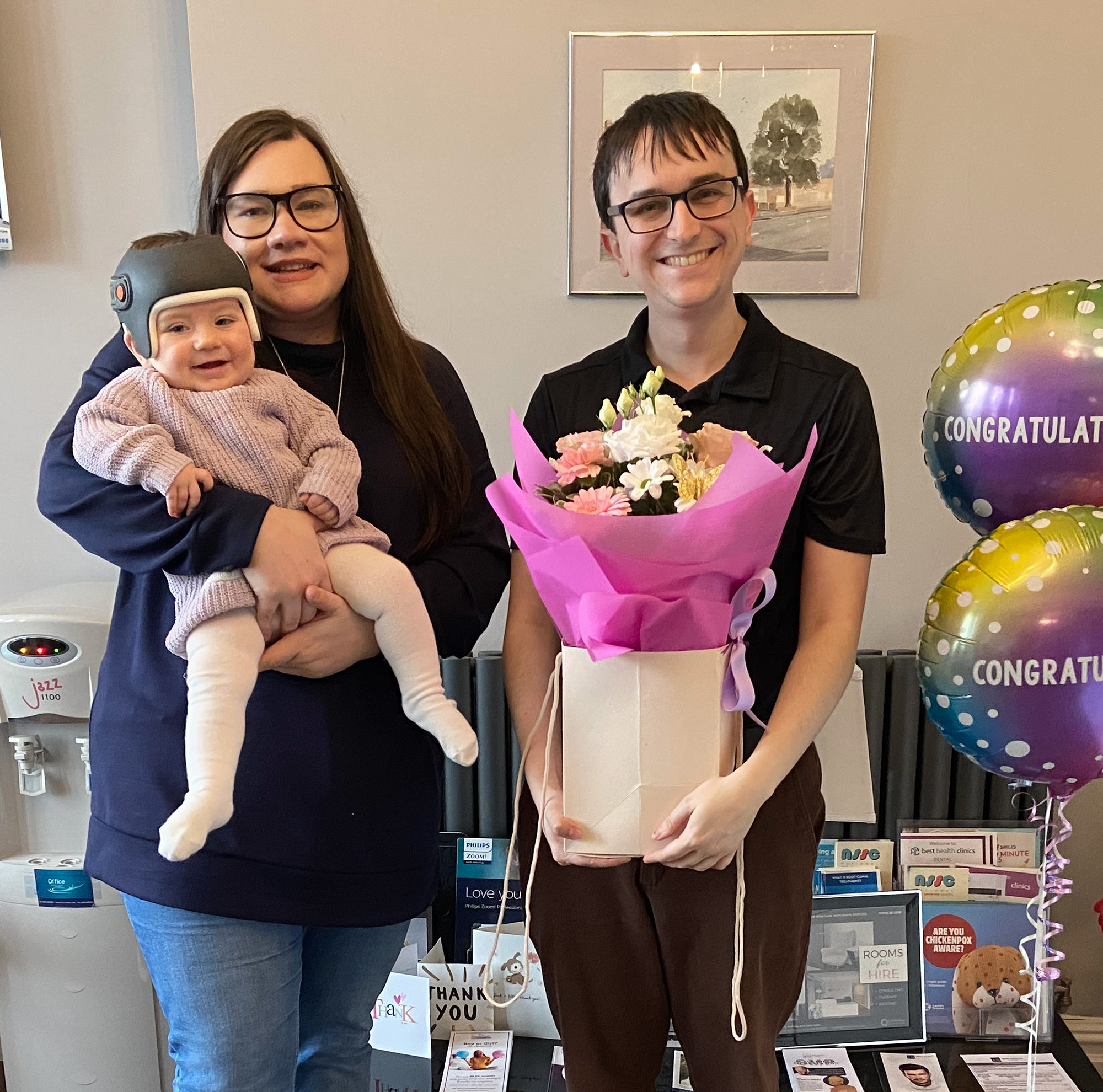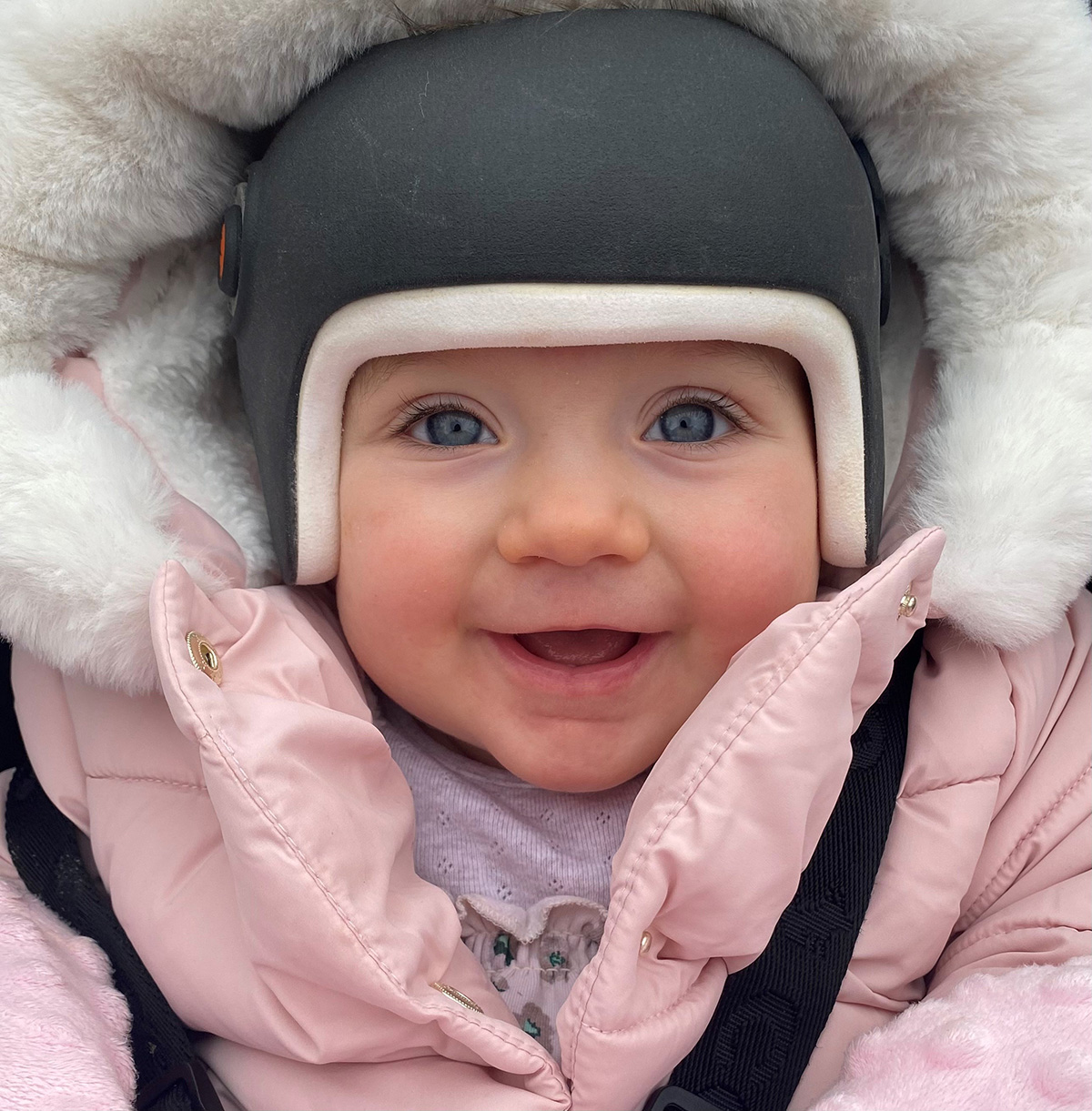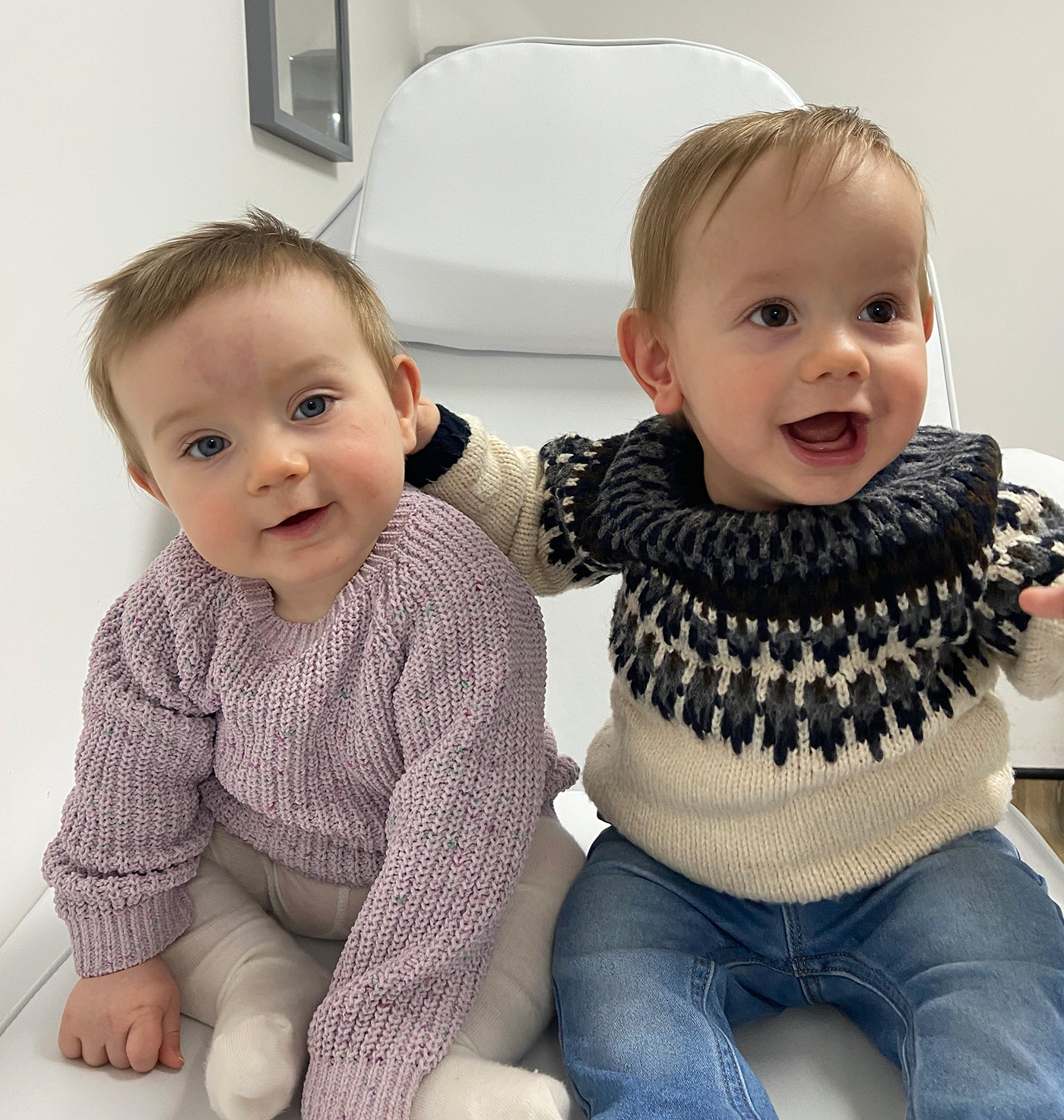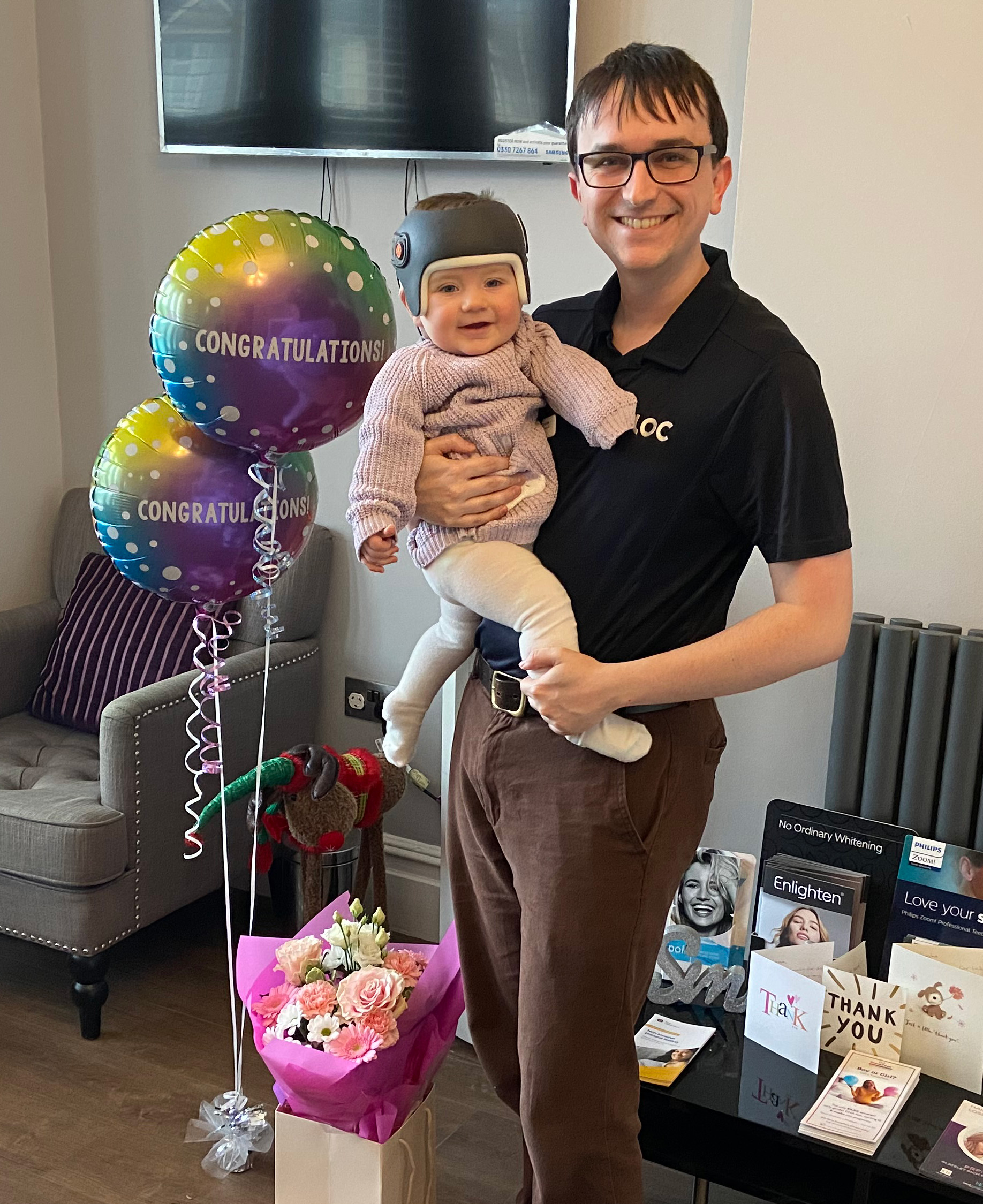
10 February 2025
A little more than four years after the LOCband Lite's launch, we're proud to have successfully treated our 250th helmet therapy patient at our Romford clinic using our cutting-edge 3D-printed cranial band.
Here are Autumn and her mum, Stephanie, celebrating the successful completion of Autumn’s treatment for plagiocephaly and brachycephaly. As a twin, Autumn had a higher risk of developing these conditions. When George first assessed her, she had a 12mm asymmetry, placing her in the severe category of plagiocephaly.
After treatment, this has improved to 3mm, which falls within the mild to normal range. Autumn and Stephanie were delighted to return to see us post-treatment, as Autumn was officially discharged today before her 1st birthday celebration. To mark the occasion, we gifted Autumn flowers and balloons.

Autumn during her helmet therapy journey
The LOCband is non-invasive and works by applying gentle, constant pressure over the areas of the baby’s skull that are most prominent while allowing unrestricted growth over the flattened areas. The band consists of a soft foam layer inside a thermoplastic shell. As the baby grows, the band will be adjusted frequently to gently guide the skull into a more symmetrical shape.
The optimum age for treatment is between four and seven months.
This is because the skull is most malleable at this age and improvements to head shape tend to take less time and are more dramatic. That is not to say that helmet therapy should be ruled out if the baby is older than seven months. Routinely, babies up to the age of 16 months can be treated very successfully.
The cut off age is around 18 months when the fontanelles (soft spots on the head) are no longer malleable. As babies grow and develop at different rates, it is always worth checking if you are not sure. There have been cases where a baby’s fontanelles have not fused yet by the age of 18 months, who have achieved successful, but less-marked results with cranial remoulding therapy.
Yes - All babies that have completed their course of treatment with us have achieved a measurable improvement in head shape. However, you don’t have to take our word for it.
Recent independent research conducted by a University Hospital in Germany has endorsed the treatment for babies with moderate or severe plagiocephaly.
A larger, retrospective study has just been published that found complete correction was achieved in 94.4% of babies treated with helmet therapy.
The results were conclusive: repositioning achieved acceptable correction in 77.1% of cases, but 15.8% were moved onto helmet therapy because re-positioning was not working. Meanwhile, 94.4% of the infants who started in the helmet-treated group achieved full correction, as did 96.1% of those who were transferred from the repositioning group into the helmet-treated group.
Further information can be found on our Plagiocephaly Research page.
This is very much dependent on how fast your baby is growing. The faster the growth, the more frequently your baby will be seen so that the helmet can be adjusted. In general, reviews will happen at two to four-week intervals.
The price of treatment covers:

Autumn (left) and her twin during an assessment in Romford
When Stephanie first noticed something unusual about her daughter Autumn, she trusted her instincts. At just four weeks old, Autumn would always turn her head to one side, even when Stephanie gently repositioned it. She also observed a slight flatness forming on the side of Autumn’s head.
Concerned, she brought it up with her health visitor, who eventually diagnosed Autumn with torticollis—a condition where tight neck muscles cause the head to tilt or turn to one side. Stephanie suspected that Autumn’s position in the womb might have contributed to her weak neck muscles and the flatness.
Determined to help Autumn, Stephanie started searching for answers. After consulting the NHS, she reached out to a cranial osteopath. Initially, the focus was on correcting Autumn’s neck tightness, but the flatness of her head persisted. The osteopath reassured Stephanie that Autumn might "grow out of it," but this vague reassurance wasn’t enough for Stephanie.
The osteopath referred her to a chiropractor, who, in turn, referred her to a doctor and then a physiotherapist. While the physiotherapist worked on Autumn’s muscle tightness, they explained that it wouldn’t alter the shape of her head. That’s when Stephanie began researching helmet therapy.

Autumn's asymmetry went from 12mm at the start of treatment to 3mm at her discharge appointment.
Her journey eventually led her to the London Orthotic Consultancy (LOC). Through Facebook support groups for parents dealing with similar challenges, Stephanie discovered LOC’s Romford clinic and decided to make an appointment.
From her first phone call with LOC, Stephanie felt reassured. George, one of LOC’s plagiocephaly specialists, made the process simple and stress-free. Stephanie, often accompanied by Autumn’s twin sibling during appointments, appreciated George’s kindness, patience, and clear communication. Another staff member comforted her during their first visit, saying, "You’re in great hands."
George thoroughly explained the process of treating flat head syndrome and conducted detailed scans of Autumn’s head. He was always ready to answer questions, even pointing Stephanie toward her chiropractor for additional insights when needed. His professional yet empathetic approach gave Stephanie the confidence she needed to move forward.

Orthotist George Coles and baby Autumn after completing her helmet therapy journey
Stephanie recalls, “Autumn adjusted quite well to her helmet, better than I had anticipated. Aside from occasional discomfort on hot nights, the helmet became part of her routine.”
Autumn was discharged on the 14th January 2025, after five months of treatment. Her final scan showed that the asymmetry had decreased from 12 mm to 3 mm, well within the range of a normal head shape.
Stephanie concludes “I give LOC a 10/10 and have recommended the LOCband Lite to other parents in my mum groups. One of those mothers is now a patient at LOC and she is also having a positive experience. I'm so pleased we went ahead with treatment.”
For Stephanie, LOC was more than just a solution—it was a supportive partner in Autumn’s journey to achieve a more symmetrical head shape. She remains grateful for the team’s care and encourages other parents to seek help if they get worried about the shape of their baby’s head.
She’s especially thankful for George’s expertise and the clinic’s supportive environment.
If you’re worried about your baby’s head shape, get in touch today. You can fill out our free flat head diagnosis form or, to book a free consultation with a clinician, contact us.